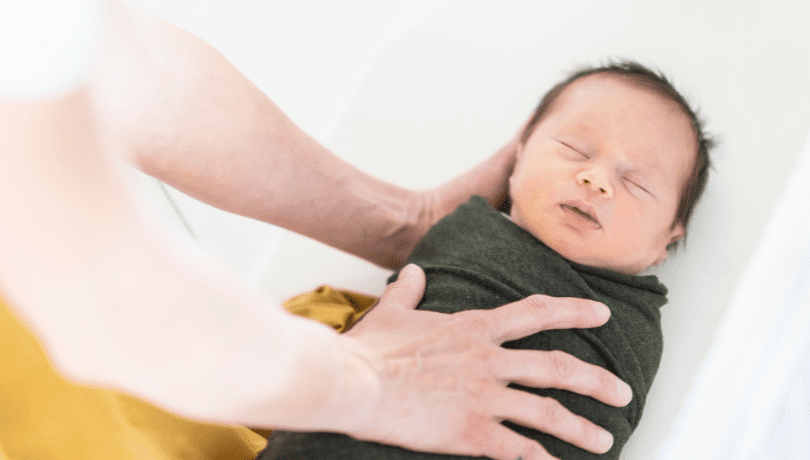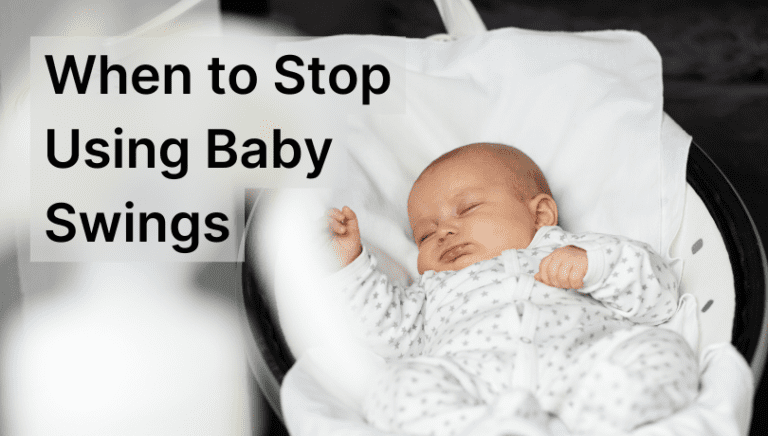5 Quick Tips to Get Baby to Sleep in Bassinets
I remember talking to my husband about how I believed we were getting better at parenting and how we’d be pros by the time our third child arrived. Boy, was I way off!
It definitely wasn’t easy to get our daughter, Fiona, to sleep in her bassinet back when she was a newborn. You may have experienced this too; your baby will wake up and protest as you set them in their bassinet or crib!
So, allow me to share my experience on how to get baby to sleep in bassinets and the tips that helped me.

Table of Contents
Why Your Newborn Won’t Sleep in Bassinets or Cribs
1. Colic or Reflux
- If you’ve just fed your baby, give them time to digest the milk before you lull them to sleep.
- Gas and reflux are common issues in children. So, try to ease their digestion as much as possible before they sleep.

2. Developing Internal Body Clock
Your baby does not yet understand the difference between day and night, causing chaos during bedtime.
- And a messy home schedule will only keep them up during odd hours!
- So, to help them understand day from night, you’ve got to start a predictable routine for them.
3. The Startle Reflex
- You may have noticed your sleeping baby jerk their arms and feet as if to hold on to something or keep themselves safe. That’s a startle or Moro reflex.
- Often, this reflex triggers when you place your baby in their bassinet a little too suddenly (causing that falling sensation), make loud noises, or otherwise startle them.
Other possible reasons why your baby won’t sleep in bassinets:
- Loud environments
- Too many distractions
- Growth and development causing sleep regression.
Kelleigh’s Note:
Your newborn should sleep only in safe sleeping environments like cribs, bassinets, or other AAP-approved sleep spaces.These safe sleep environments shield your newborn from accidental suffocation, SIDS, and other entanglement.
Recommended Reading: 5 Safety Tips for Bassinets
5 Helpful Tips | How to Get Baby to Sleep in Bassinets
1. Bedtime Routines
We’re all creatures of habit to some extent, and babies find comfort in healthy routines. So, an hour before sleep, give them their bath, feed them, change their clothes, and gently place them in their bassinets.

- If your baby experiences colic or reflux, sit them upright after a feed and gently pat or rub their back. This will help them pass gas or burp for some relief.
- At some time during the routine, you can also warm up the bassinet’s mattress using a hot water bag for extra comfort and remove it when you’re ready to place your baby in the bassinet.
- Also, please continue to engage with your baby in the bassinet and stay beside them as they explore with their senses! Your calming presence and voice will always help your baby relax and lull them to sleep.
2. Room-Sharing
Bassinets are almost always more compact than cribs, and many can be moved from room to room. I got Fiona the portable kind to room-share with her.
- While bed-sharing with your newborn is a strict no, room-sharing is often helpful. So, Terry or I would rock little Fiona in our arms and settle her into the bassinet just next to us as she nods off.
- When she would fuss, we soothe her quickly, rocking the bassinet. BUT, we try not to pick her up from the bassinet (this part’s crucial, dear parents).
- In the beginning, we soothed her this way quite often, but pretty soon, she came to associate the bassinet with comfort and safety and woke up less and less.
Recommended Reading: Co-Sleeper vs Bassinet
3. The Right Bassinet
I got Fiona a portable bassinet that could also double as a bedside bassinet. Terry and I felt that we needed this since Fiona needed time to adjust to her new surroundings.

So, please choose a bassinet that keeps your baby comfortable and fits your family’s needs.
- Today, many bassinets come with wheels and storage sections to keep your baby’s diapers and toys within reach and move them around.
- You can also attach bassinets to your bed to room-share with your newborn, especially if your little one wakes up for nightly feeds.
- You can even get the traditional bassinets that stay in one place, perfect for your nursery or other compact rooms.
Also, I understand that many parents do not prefer the mattress that comes with the bassinet. So, if your baby shuns the bassinet, you could also invest in a better mattress. I also have a bassinet mattress guide with my top 3 mattress picks to help you.
4. The Right Positioning
We know that it’s good to have a bedtime routine. And when the time comes to place your baby in their bassinet, place them in gently on their backs, the lower half first. Why?

- Imagine how you lay down to sleep. You’d first get comfy from your bum to your feet and back, and finally, your head meets the bed. Follow the same process when you position your baby.
- If you place their head in first, it can cause that falling feeling (startle reflex) to hit them, waking them up. So, that’s a strong no! Tushy first, always!
- You can also swaddle them before they sleep (more on this below)! This can prevent that startle reflex from waking your newborn up.
5. No Distractions
- When putting your baby to sleep in their bassinet, make sure the room is quiet and calm.
- I’ve got multiple kids at home, so, whenever I needed to put my then newborn to sleep, I’d have Terry gather the other kids into the drawing room, away from the main bedroom.
More Ways to Create a Sleep-Friendly Environment
Neighbors and friends of mine swear by these useful techniques and products that have helped them put their newborns to sleep in bassinets easily.
- Swaddling – Wrapping your baby up in a swaddle can help them self-soothe, reduce fuss, and gradually get them used to sleeping in bassinets.
- Blackout Curtains – Whether you room-share with your baby or they sleep in a nursery, install blackout curtains to block out sunlight and create a calm, dim atmosphere for better sleep.
- Cozy Bedding – Newborns indeed need a firm sleeping surface for safe sleep. But even firm sleep surfaces can be comfy. So, find bassinet mattresses that balance out firmness and comfort.
- White Noise Machines – You can invest in white noise machines that play calming, soothing music or nature sounds, so your baby can sleep better.
FAQs on Swaddling
Swaddling – When you wrap your baby up in a blanket gently to help them relax and sleep.

1. How Does Swaddling Help Relax My Baby?
1. The snug wrap resembles the closed space of the womb and also mimics a parent’s hold to keep your baby feeling calm and secure.
2. It can also help reduce startle reflex, and a breathable swaddling cloth can keep your baby sufficiently warm, without overheating.
3. It has also been known to help relieve symptoms of colic since it lightly presses on your baby’s tummy.
2. Can You Put A Newborn In A Bassinet Without Swaddling?
Yes, that’s perfectly fine.
Swaddling is something you can consider when your baby is extremely fussy about sleeping in bassinets or cribs, and you’ve found that nothing else helps.
Further Reading: Why Your Newborn Hates the Swaddle
3. What Are The Risks of Swaddling?
If your swaddled baby rolls onto their stomach somehow, they’ll be unable to move and that can cause SIDS or accidental suffocation.
To prevent such risks, you should know that it’s crucial to stop swaddling when they begin to roll over, and that usually occurs between 2 and 4 months.
Also, ensure that you do not swaddle them too tight, because over time, that can cause issues like hip dysplasia, or delays in development.
4. What Can I Use Instead of a Swaddle?
As an alternative to swaddles, you can use
Wearable blankets, or
Sleeping bags for babies
You can also get adjustable swaddles that you can loosen when you need to.
Wrapping Up: Creating Comfy Sleep Spaces
If your baby doesn’t like sleeping in a bassinet, keep calm and follow a plan!
Have a solid bedtime routine, place your baby gently to avoid startle reflexes, and make them sleep in a quiet and dark room. You can also try room-sharing and invest in a bedside bassinet to stay near your little one.
Also, I’d always suggest you use swaddles or other alternatives only after you’ve exhausted all other options. If you are still facing issues, please contact your pediatrician and clarify all your doubts.
You’ve got this, dear parent.






